Diamond Photoconductive Antenna for Terahertz Generation Equipped with Buried Graphite Electrodes
Abstract
1. Introduction
2. Materials and Methods
3. Results
4. Conclusions
Author Contributions
Funding
Institutional Review Board Statement
Informed Consent Statement
Data Availability Statement
Acknowledgments
Conflicts of Interest
References
- Hafez, H.A.; Chai, X.; Ibrahim, A.; Mondal, S.; Férachou, D.; Ropagnol, S.X.; Ozaki, T. Intense terahertz radiation and their applications. J. Opt. 2016, 18, 093004. [Google Scholar] [CrossRef]
- Chai, X.; Ropagnol, A.; Ovchinnikov, O.; Chefonov, A.; Ushakov, C.; Garcia-Rosas, C.M.; Isgandarov, E.; Agranat, M.; Ozaki, T.; Savel’ev, A. Observation of crossover from intraband to interband nonlinear terahertz optics. Opt. Lett. 2018, 43, 5463. [Google Scholar] [CrossRef] [PubMed]
- Jones, D.Y.; Bucksbaum, P. Ionization of Rydberg atoms by subpicosecond half-cycle electromagnetic pulses. Phys. Rev. Lett. 1993, 70, 1236. [Google Scholar] [CrossRef] [PubMed]
- Nicoletti, D.; Cavalleri, A. Nonlinear light–matter interaction at terahertz frequencies. Adv. Opt. Photon 2016, 8, 401–464. [Google Scholar] [CrossRef]
- Tanaka, K.; Hirori, H.; Nagai, M. THz Nonlinear Spectroscopy of Solids. IEEE Trans. Terahertz Sci. Technol. 2011, 1, 301–312. [Google Scholar] [CrossRef]
- Peng, Y.; Shi, C.; Zhu, Y.; Gu, M.; Zhuang, S. Terahertz spectroscopy in biomedical field: A review on signal-to-noise ratio improvement. PhotoniX 2020, 1, 12. [Google Scholar] [CrossRef]
- Gong, A.; Qiu, Y.; Chen, X.; Zhao, Z.; Xia, L.; Shao, Y. Biomedical applications of terahertz technology. Appl. Spectrosc. Rev. 2020, 55, 418–438. [Google Scholar] [CrossRef]
- Federici, J.; Schulkin, B.; Huang, F.; Gary, D.; Barat, R.; Oliveira, F.; Zimdars, D. THz imaging and sensing for security applications—Explosives, weapons and drugs. Semicond. Sci. Nd Technol. 2005, 20, S266. [Google Scholar] [CrossRef]
- Ren, A.; Zahid, A.; Fan, D.; Yang, X.; Imran, M.A.; Alomainy, A.; Abbasi, Q.H. State-of-the-art in terahertz sensing for food and water security—A comprehensive review. Trends Food Sci. Technol. 2019, 85, 241–251. [Google Scholar] [CrossRef]
- John, T.; Chengjie, X.; Nathan, J.; Kiarash, A.; Navid, A. Review of THz-based semiconductor assurance. Opt. Eng. 2021, 60, 060901. [Google Scholar]
- Castro-Camus, E.; Koch, M.; Mittleman, D.M. Recent advances in terahertz imaging: 1999 to 2021. Appl. Phys. B 2022, 128, 12. [Google Scholar] [CrossRef]
- Koenig, S.; Lopez-Diaz, D.; Antes, J.; Boes, F.; Henneberger, R.; Leuther, A.; Tessmann, A.; Schmogrow, R.; Hillerkuss, D.; Palmer, R.; et al. Wireless sub-THz communication system with high data rate. Nat. Photonics 2013, 7, 977–981. [Google Scholar] [CrossRef]
- Isgandarov, E.; Ropagnol, X.; Singh, M.; Ozaki, T. Intense terahertz generation from photoconductive antennas. Front. Optoelectron. 2021, 14, 64. [Google Scholar] [CrossRef]
- Burford, N.; El-Shenawee, M. Review of terahertz photoconductive antenna technology. Opt. Eng. 2017, 56, 010901. [Google Scholar] [CrossRef]
- Zhang, X.C.; Shkurinov, A.; Zhang, Y. Extreme terahertz science. Nat. Photonics 2017, 11, 16–18. [Google Scholar] [CrossRef]
- Vicario, C.; Jazbinsek, M.; Ovchinnikov, A.V.; Chefonov, O.V.; Ashitkov, S.I.; Agranat, M.B.; Hauri, C.P. High efficiency THz generation in DSTMS, DAST and OH1 pumped by Cr: Forsterite laser. Opt. Express 2015, 23, 4573–4580. [Google Scholar] [CrossRef]
- Oh, T.; Yoo, Y.; You, Y.; Kim, K.-Y. Generation of strong terahertz fields exceeding 8 MV/cm at 1 kHz and real-time beam profiling. Appl. Phys. Lett. 2014, 105, 041103. [Google Scholar] [CrossRef]
- Yoneda, H.; Ueda, K.-i.; Aikawa, Y.; Baba, K.; Shohata, N. Photoconductive properties of chemical vapor deposited diamond switch under high electric field strength. Appl. Phys. Lett. 1995, 66, 460–462. [Google Scholar] [CrossRef]
- Yoneda, H.; Tokuyama, K.; Ueda, K.-I.; Yamamoto, H.; Baba, K. High-power terahertz radiation emitter with a diamond photoconductive switch array. Appl. Opt. 2001, 40, 6733–6736. [Google Scholar] [CrossRef]
- Chizhov, P.A.; Komlenok, M.S.; Kononenko, V.V.; Bukin, V.V.; Ushakov, A.A.; Bulgakova, V.V.; Khomich, A.A.; Bolshakov, A.P.; Konov, V.I.; Garnov, S.V. Photoconductive terahertz generation in nitrogen-doped single-crystal diamond. Opt. Lett. 2022, 47, 86–89. [Google Scholar] [CrossRef]
- Kononenko, V.V.; Komlenok, M.S.; Chizhov, P.A.; Bukin, V.V.; Bulgakova, V.V.; Khomich, A.A.; Bolshakov, A.P.; Konov, V.I.; Garnov, S.V. Efficiency of photoconductive terahertz generation in nitrogen-doped diamonds. Photonics 2022, 9, 18. [Google Scholar] [CrossRef]
- Kononenko, T.V.; Konov, V.I.; Pimenov, S.M.; Rossukanyi, N.M.; Rukovishnikov, A.I.; Romano, V. Three-dimensional laser writing in diamond bulk. Diam. Relat. Mater. 2011, 20, 264–268. [Google Scholar] [CrossRef]
- Oh, A.; Caylar, B.; Pomorski, M.; Wengler, T. A novel detector with graphitic electrodes in CVD diamond. Diam. Relat. Mater. 2013, 38, 9–13. [Google Scholar] [CrossRef]
- Lagomarsino, S.; Bellini, M.; Corsi, C.; Gorelli, F.; Parrini, G.; Santoro, M.; Sciortino, S. Three-dimensional diamond detectors: Charge collection efficiency of graphitic electrodes. Appl. Phys. Lett. 2013, 103, 233507. [Google Scholar] [CrossRef]
- Kononenko, T.; Ralchenko, V.; Bolshakov, A.; Konov, V.; Allegrini, P.; Pacilli, M.; Conte, G.; Spiriti, E. All-carbon detector with buried graphite pillars in CVD diamond. Applied Physics A 2014, 114, 297–300. [Google Scholar] [CrossRef]
- Nistor, V.; Stefan, M.; Ralchenko, V.; Khomich, A.; Schoemaker, D. Nitrogen and hydrogen in thick diamond films grown by microwave plasma enhanced chemical vapor deposition at variable H2 flow rates. J. Appl. Phys. 2000, 87, 8741–8746. [Google Scholar] [CrossRef]
- Ashikkalieva, K.K.; Kononenko, T.V.; Ashkinazi, E.E.; Obraztsova, E.A.; Mikhutkin, A.A.; Timofeev, A.A.; Konov, V.I. Internal structure and conductivity of laser-induced graphitized wires inside diamond. Diam. Relat. Mater. 2022, 128, 109243. [Google Scholar] [CrossRef]
- Lagomarsino, S.; Bellini, M.; Corsi, C.; Fanetti, S.; Gorelli, F.; Liontos, I.; Parrini, G.; Santoro, M.; Sciortino, S. Electrical and Raman-imaging characterization of laser-made electrodes for 3D diamond detectors. Diam. Relat. Mater. 2014, 43, 23–28. [Google Scholar] [CrossRef]
- Reid, M.; Fedosejevs, R. Quantitative comparison of terahertz emission from (100) InAs surfaces and a GaAs large-aperture photoconductive switch at high fluences. Appl. Opt. 2005, 44, 149–153. [Google Scholar] [CrossRef]
- Turton, D.A.; Welsh, G.H.; Carey, J.J.; Reid, G.D.; Beddard, G.S.; Wynne, K. Alternating high-voltage biasing for terahertz large-area photoconductive emitters. Rev. Sci. Instrum. 2006, 77, 083111. [Google Scholar] [CrossRef]
- Ropagnol, X.; Chai, X.; Raeis-Zadeh, S.M.; Safavi-Naeini, S.; Kirouac-Turmel, M.; Bouvier, C.Y.; Côté, M.; Reid, M.; Gauthier, M.A.; Ozaki, T. Influence of Gap Size on Intense THz Generation from ZnSe Interdigitated Large Aperture Photoconductive Antennas. IEEE J. Sel. Top. Quantum Electron. 2017, 23, 1–8. [Google Scholar] [CrossRef]
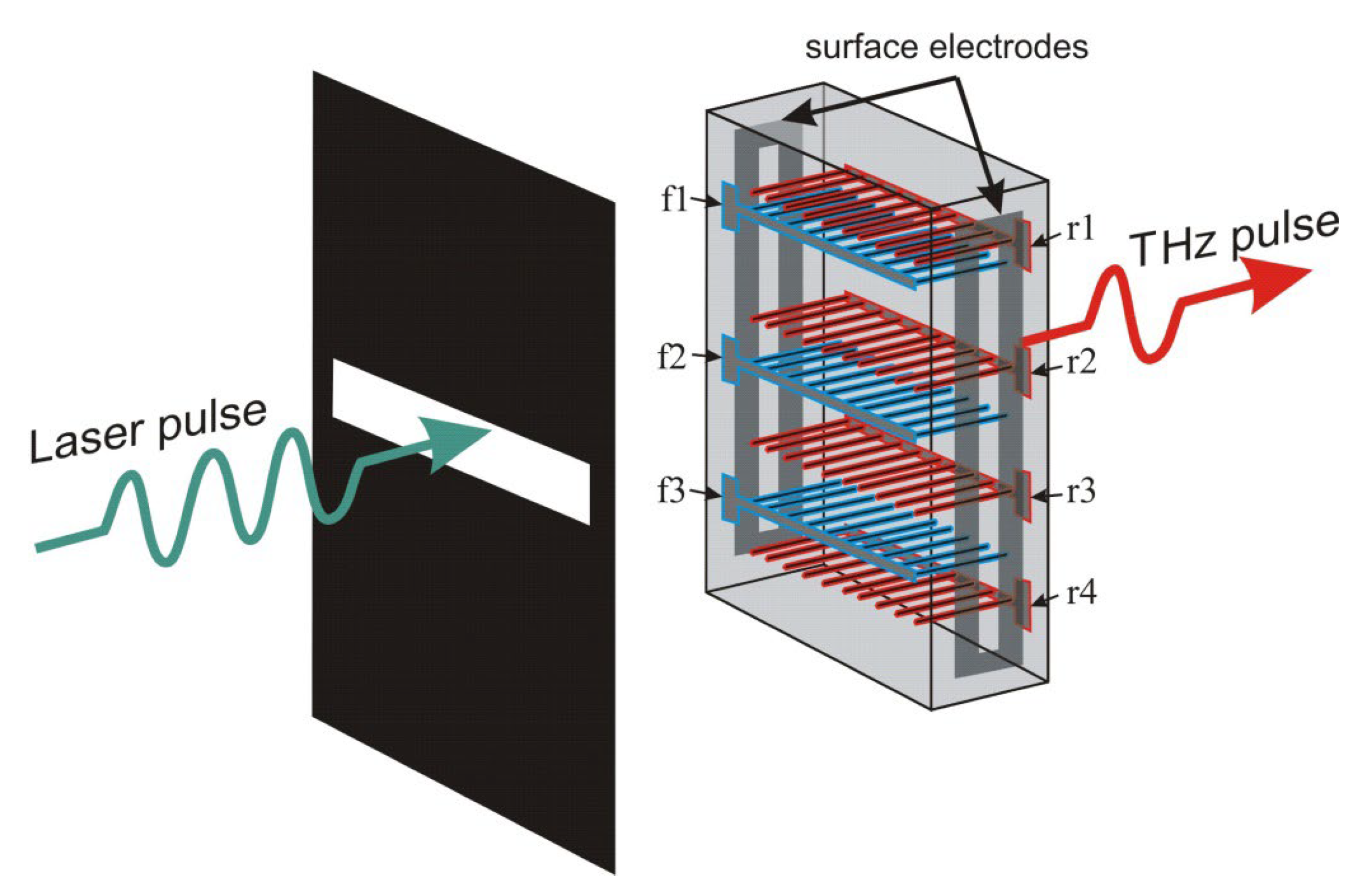

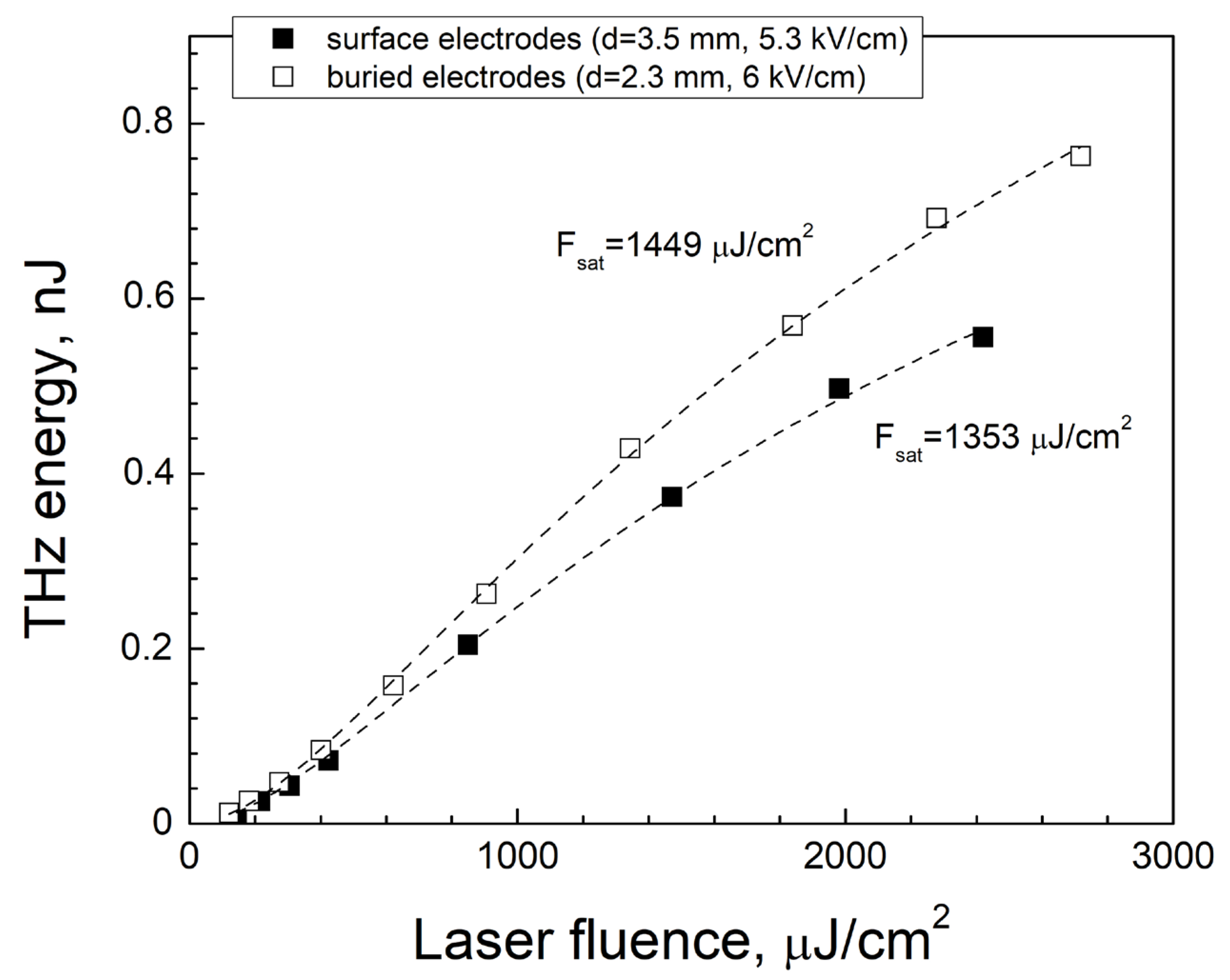
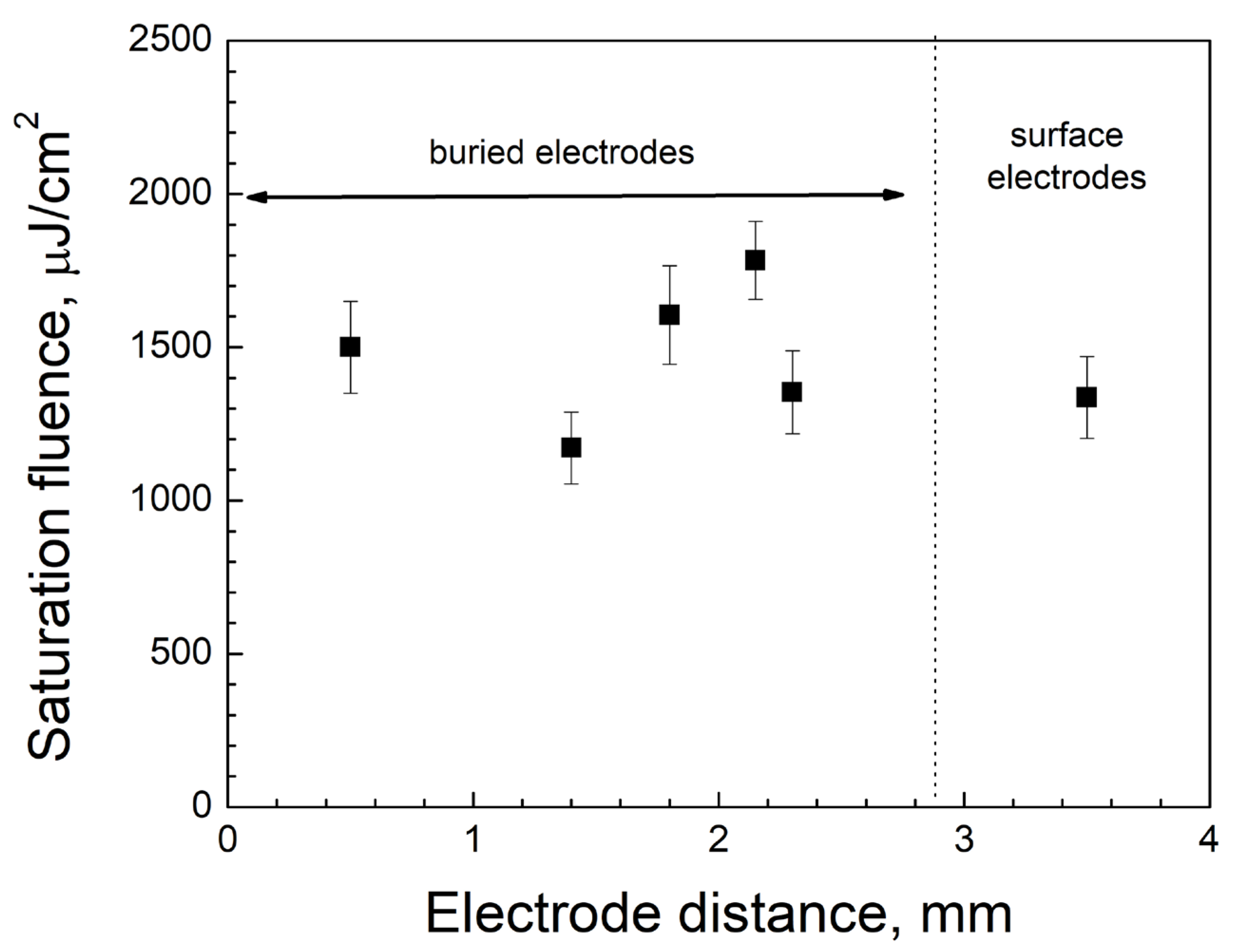
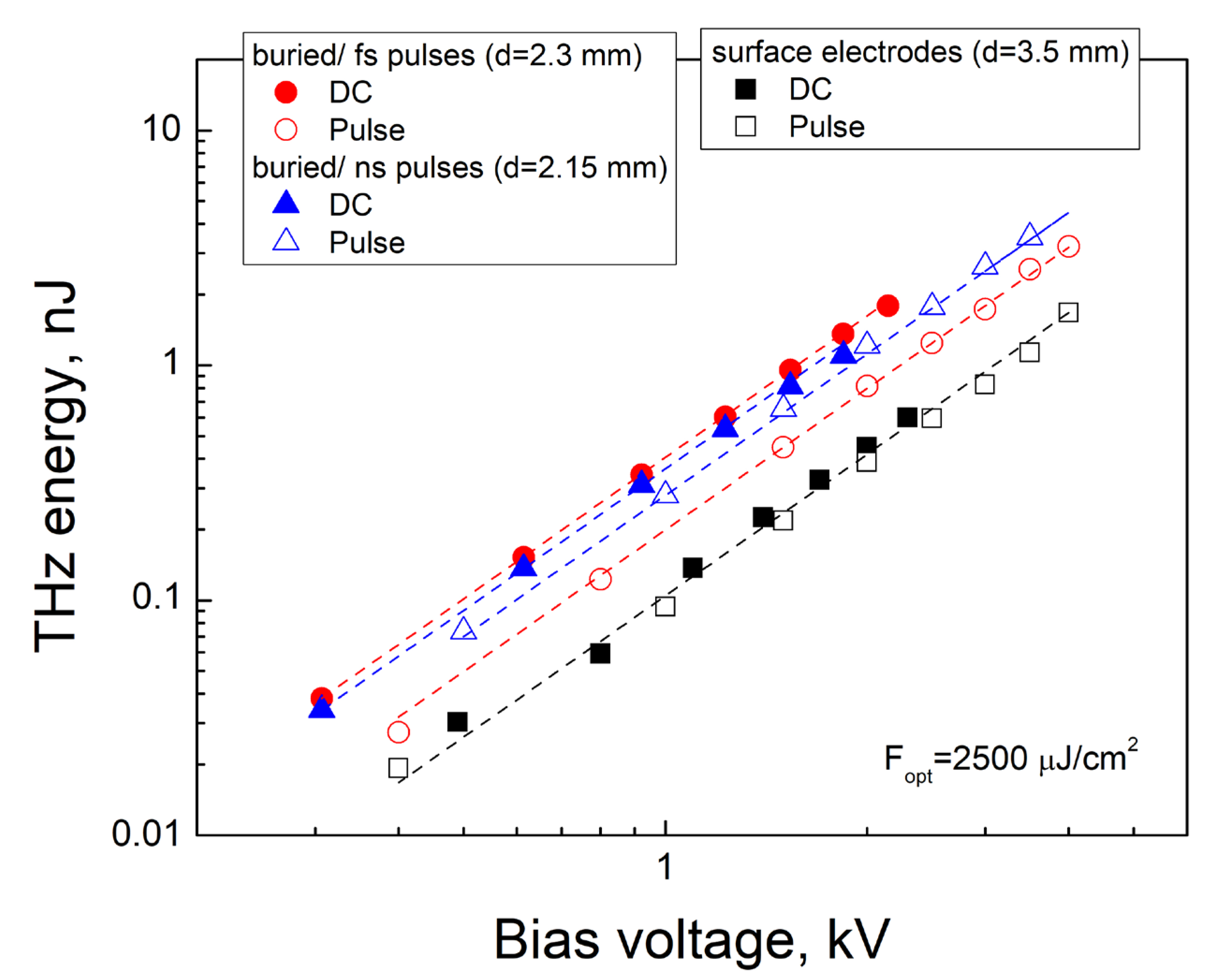
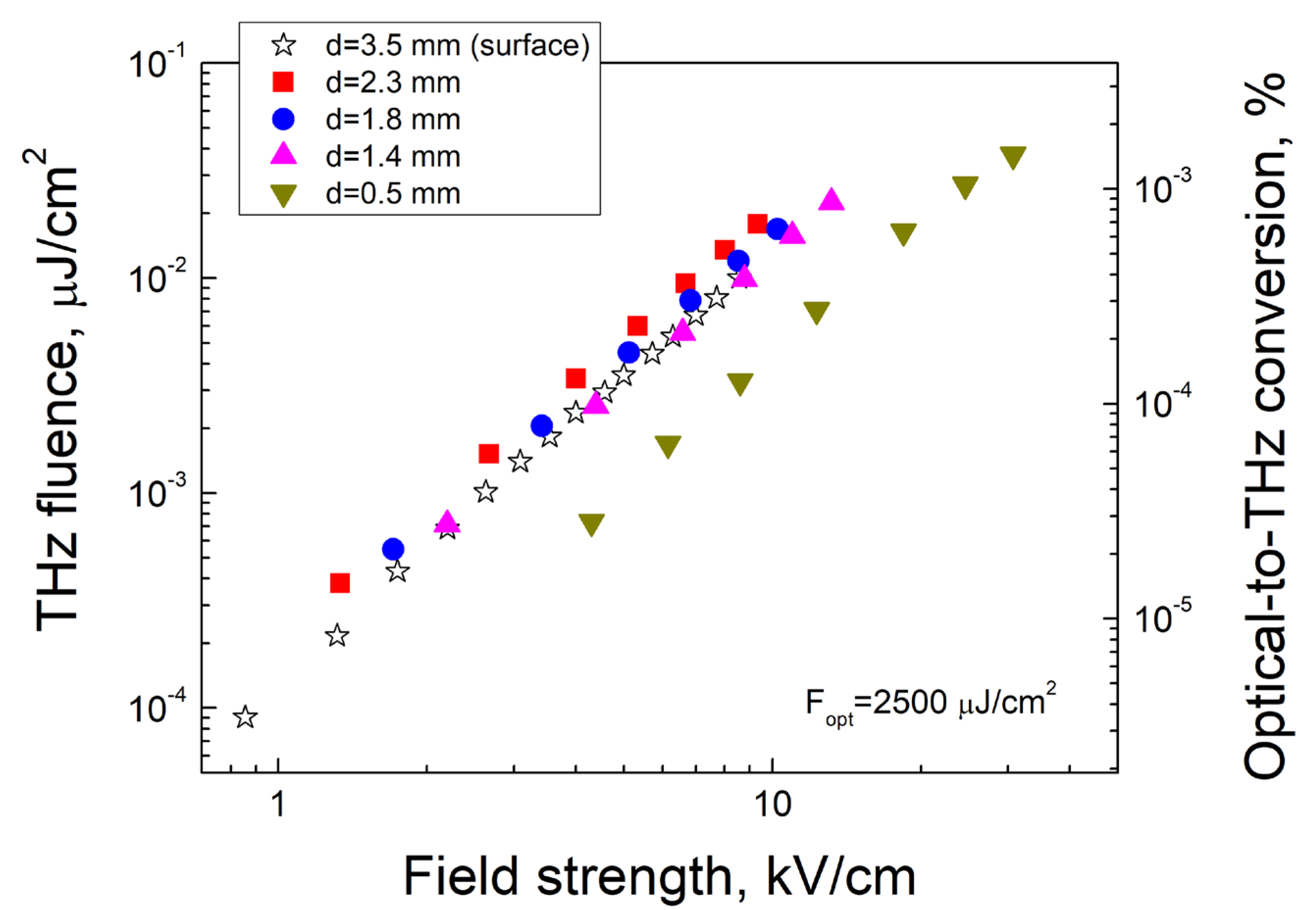
| PCA | Type of Electrodes | Electrode Interspace | Electrode Position |
|---|---|---|---|
| #1 | surface | 3.5 mm | side faces |
| #2 | buried: f1 + r4 (fs) | 2.3 mm | front/rear faces |
| #3 | buried: r2 + r4 (fs) | 1.8 mm | rear faces |
| #4 | buried: f1 + r3 | 1.4 mm | front/rear faces |
| #5 | buried: f1 + r2 (fs) | 0.5 mm | front/rear faces |
| #6 | buried: f3 + r1 (ns) | 2.15 mm | front/rear faces |
Disclaimer/Publisher’s Note: The statements, opinions and data contained in all publications are solely those of the individual author(s) and contributor(s) and not of MDPI and/or the editor(s). MDPI and/or the editor(s) disclaim responsibility for any injury to people or property resulting from any ideas, methods, instructions or products referred to in the content. |
© 2023 by the authors. Licensee MDPI, Basel, Switzerland. This article is an open access article distributed under the terms and conditions of the Creative Commons Attribution (CC BY) license (https://creativecommons.org/licenses/by/4.0/).
Share and Cite
Kononenko, T.V.; Ashikkalieva, K.K.; Kononenko, V.V.; Zavedeev, E.V.; Dezhkina, M.A.; Komlenok, M.S.; Ashkinazi, E.E.; Bukin, V.V.; Konov, V.I. Diamond Photoconductive Antenna for Terahertz Generation Equipped with Buried Graphite Electrodes. Photonics 2023, 10, 75. https://doi.org/10.3390/photonics10010075
Kononenko TV, Ashikkalieva KK, Kononenko VV, Zavedeev EV, Dezhkina MA, Komlenok MS, Ashkinazi EE, Bukin VV, Konov VI. Diamond Photoconductive Antenna for Terahertz Generation Equipped with Buried Graphite Electrodes. Photonics. 2023; 10(1):75. https://doi.org/10.3390/photonics10010075
Chicago/Turabian StyleKononenko, Taras Viktorovich, Kuralai Khamitzhanovna Ashikkalieva, Vitali Viktorovich Kononenko, Evgeny Viktorovich Zavedeev, Margarita Alexandrovna Dezhkina, Maxim Sergeevich Komlenok, Evgeny Evseevich Ashkinazi, Vladimir Valentinovich Bukin, and Vitaly Ivanovich Konov. 2023. "Diamond Photoconductive Antenna for Terahertz Generation Equipped with Buried Graphite Electrodes" Photonics 10, no. 1: 75. https://doi.org/10.3390/photonics10010075
APA StyleKononenko, T. V., Ashikkalieva, K. K., Kononenko, V. V., Zavedeev, E. V., Dezhkina, M. A., Komlenok, M. S., Ashkinazi, E. E., Bukin, V. V., & Konov, V. I. (2023). Diamond Photoconductive Antenna for Terahertz Generation Equipped with Buried Graphite Electrodes. Photonics, 10(1), 75. https://doi.org/10.3390/photonics10010075





